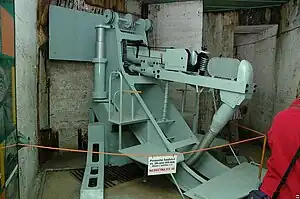Škoda 10 cm vz. 38 howitzer
The Škoda 10 cm vz. 38 was a light howitzer deployed in single gun defensive casemates in the Czechoslovak border fortifications before World War II.
| Škoda 10 cm vz. 38 | |
|---|---|
 Mock up of a Škoda 10 cm vz. 38 howitzer N-D-S 75 at fortress Dobrošov near Náchod. | |
| Place of origin | Czechoslovakia |
| Service history | |
| Wars | World War II |
| Production history | |
| Designer | Skoda |
| Designed | 1935 |
| Manufacturer | Skoda |
| Produced | 1938 |
| No. built | 15 |
| Specifications | |
| Length | 3.25 m (10 ft 8 in) |
| Barrel length | 2.5 m (8 ft 2 in) |
| Crew | 2 |
| Shell | Fixed QF ammunition |
| Shell weight | 16 kg (35 lb) |
| Caliber | 100 mm (3.9 in) |
| Breech | Semi-automatic vertical sliding breech block |
| Carriage | Single mount casemates |
| Elevation | -10° to +38° |
| Traverse | Early mounts: -22.3° to +22.3° Later mounts: -30° to +30° |
| Rate of fire | 7 rpm |
| Muzzle velocity | 525 m/s (1,720 ft/s) |
| Maximum firing range | 12 km (7.5 mi) |
History
The Škoda 10 cm vz. 38 was developed and built by Škoda at the Pilsen works. Development of the howitzer began in March 1935 after an order was placed by the Czechoslovakian Department of National Defense. The design was based on an existing field howitzer the 10 cm vz. 30. The howitzer was put into production during 1938 and fifteen were completed but never deployed to the Czechoslovakian border fortifications. After occupation Czechoslovakia by Germany in 1939, the howitzers were seized and allegedly used by the German Army. After World War II all fifteen howitzers were scrapped. Today two wood and metal mock ups of the howitzers are housed in the museum of artillery at fort Dobrošov near Náchod. The mock ups were acquired in 1973 from the museum of artillery at fort Hanicka and used as props in the filming of Days of betrayal by director Otakar Vavra.